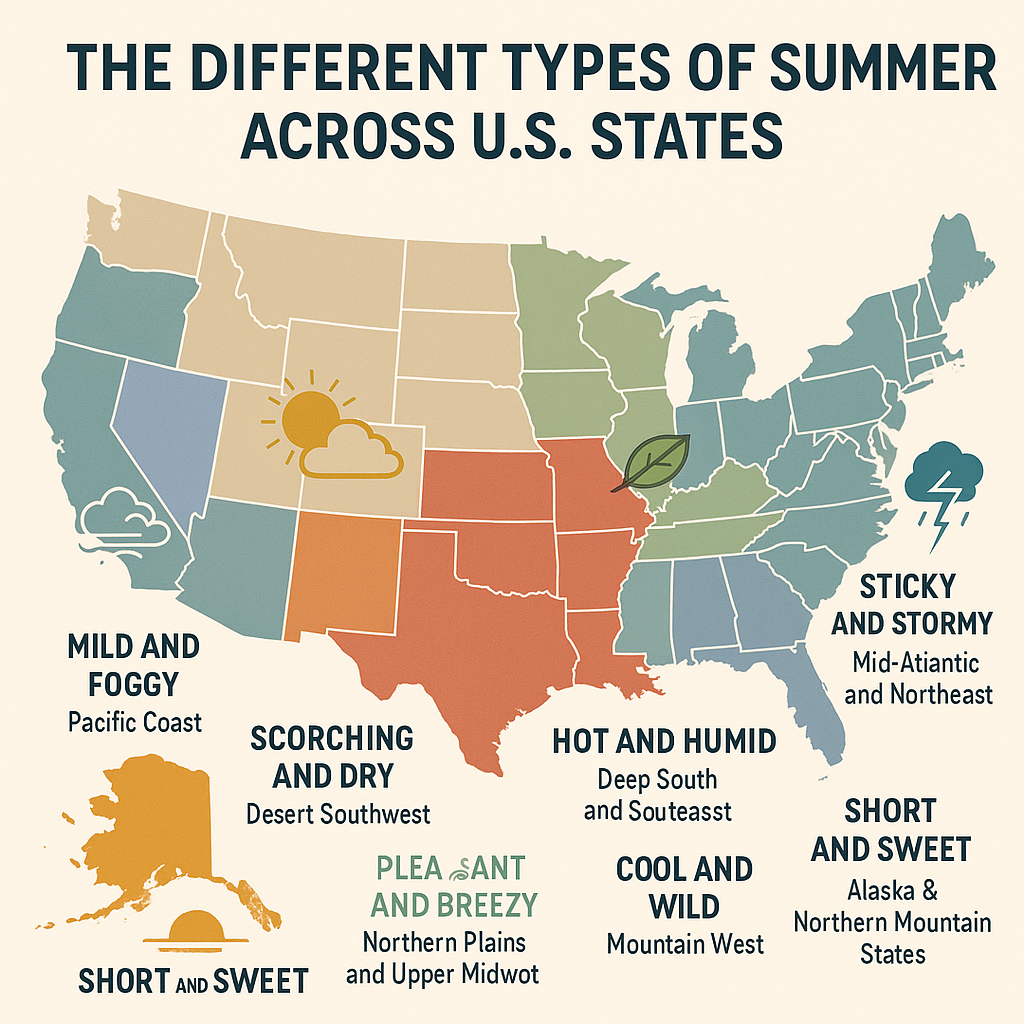50 Summers, 50 Stories: How Summer Feels in Every Corner of the U.S.

Summer in the United States is as diverse as the landscape itself. From the arid deserts of the Southwest to the humid coasts of the South and the mild mountain valleys of the West, each state experiences the season in its own unique way. Understanding the different types of summer across the U.S. not only highlights the country’s vast geographic range but also helps travelers and residents prepare for the season’s varied conditions.
1. Scorching and Dry: The Desert Southwest
States: Arizona, Nevada, New Mexico, parts of California and Texas
In places like Phoenix or Las Vegas, summer means relentless heat with daytime temperatures frequently soaring above 110°F (43°C). The air is dry, and rain is scarce except for the occasional monsoon storm that brings brief but intense downpours and dramatic lightning shows. Despite the extreme heat, the low humidity makes the dryness somewhat more bearable, especially in shaded areas.
Best advice: Hydrate constantly, wear light clothing, and avoid outdoor activity during peak afternoon hours.
2. Hot and Humid: The Deep South and Southeast
States: Florida, Georgia, Louisiana, Mississippi, Alabama, South Carolina, eastern Texas
This region is known for its high temperatures paired with stifling humidity. Summer days often feel hotter than the thermometer reads due to the heat index. Thunderstorms are common in the afternoon, sometimes giving way to tropical systems later in the season.
Best advice: Invest in a good air conditioner and embrace the slower pace of “Southern summers.”
3. Mild and Foggy: The Pacific Coast
States: California (coastal), Oregon, Washington
While much of the U.S. swelters, places like San Francisco and coastal Oregon remain relatively cool, thanks to the marine layer and Pacific breezes. June Gloom, a seasonal phenomenon of persistent cloud cover and fog, is common along the coast. Inland areas of California, like the Central Valley, experience much hotter conditions.
Best advice: Pack a jacket—even in July—if you’re staying near the coast.
4. Pleasant and Breezy: The Northern Plains and Upper Midwest
States: Minnesota, North Dakota, South Dakota, Wisconsin, Iowa
These areas enjoy some of the most comfortable summers in the country. Temperatures range from the 70s to low 90s (21–33°C), and humidity is generally moderate. Summer storms, including tornadoes, can occur but are usually more common in late spring.
Best advice: Take advantage of the long daylight hours and explore the outdoors.
5. Cool and Wild: The Mountain West
States: Colorado, Utah, Wyoming, Montana, Idaho
Elevated terrain means milder summers, especially in mountainous regions. Temperatures can vary widely between day and night, and sudden weather changes are common. Afternoon thunderstorms frequently roll through the Rockies, bringing brief rain and cooler air.
Best advice: Dress in layers and be weather-aware when hiking or camping.
6. Sticky and Stormy: The Mid-Atlantic and Northeast
States: New York, New Jersey, Pennsylvania, Maryland, Virginia
Summer in this region can be unpredictable. Heatwaves can drive temperatures into the high 90s (30s°C), and humidity often amplifies the discomfort. Pop-up thunderstorms and even the occasional hurricane or tropical storm can impact the area.
Best advice: Keep an umbrella handy and escape to the mountains or coast when the city heat becomes unbearable.
7. Short and Sweet: Alaska and Northern Mountain States
States: Alaska, parts of Montana, Idaho, and Wyoming
Alaska’s summer is brief but magical. Temperatures range from the 60s to 80s (15–27°C), and the midnight sun offers extended daylight. In the northernmost parts, the sun may not set for weeks. Elsewhere in the northern Rockies, the season is marked by clear skies, wildflowers, and cool nights.
Best advice: Soak up every sunny day—summer is fleeting this far north.
Conclusion
The summer season in the United States is a tapestry woven from diverse climate zones, geography, and local culture. Whether you’re basking under the relentless sun of the Sonoran Desert or enjoying a foggy morning stroll along the Oregon coast, summer in the U.S. is never a one-size-fits-all experience. Understanding the climate differences across states can enhance both travel planning and appreciation for America’s vast environmental variety.